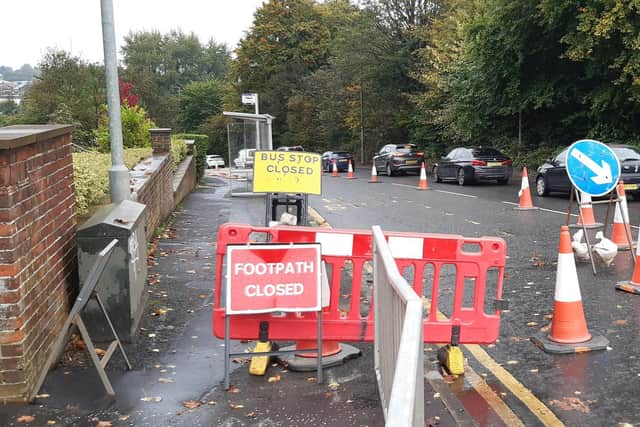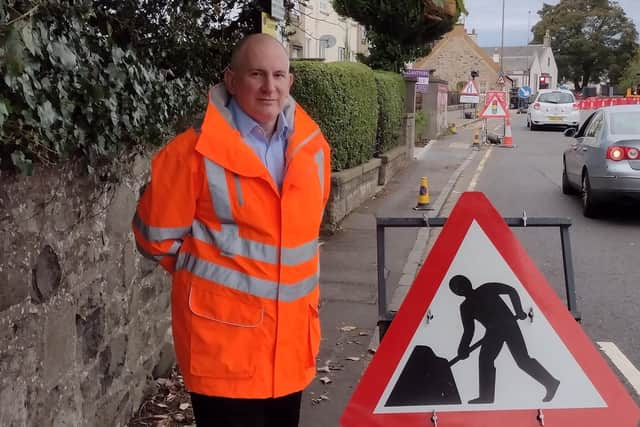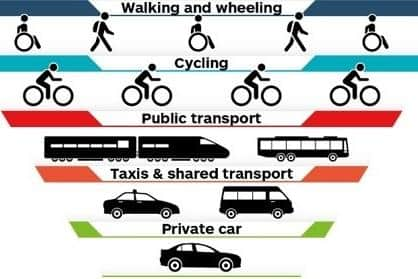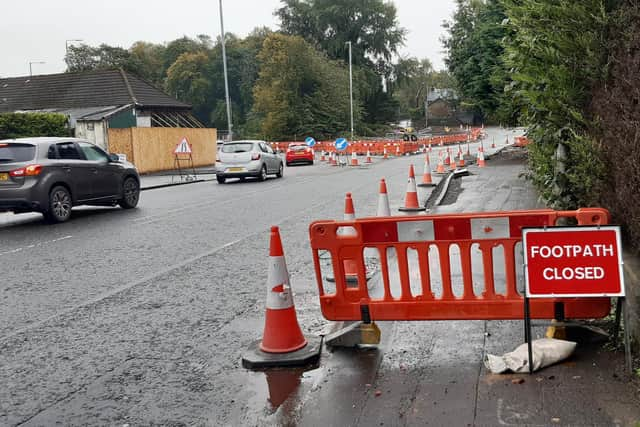Keep pavements and cycle lanes open in roadworks even if it delays other traffic – Scottish Road Works Commissioner
Pavements and cycle lanes should be kept open during roadworks to give priority to pedestrians and riders even it increases delays to other traffic, the Scottish Road Works Commissioner has told The Scotsman.
Kevin Hamilton said the first major review for decades of the “Red Book" roadworks code of practice must give precedence to those at the top of the Scottish Government’s “transport hierarchy”.
Advertisement
Hide AdAdvertisement
Hide AdThis puts walkers and wheelers at the top, followed by cyclists, then public transport such as trains and buses, then taxis and other shared transport, with cars at the bottom.


Roadworks are running at record levels, 60 per cent of which are on pavements.
Mr Hamilton, who was appointed in 2020 by ministers to oversee improvements to the planning, co-ordination and quality of roadworks, said pedestrians were often confronted with “Footpath Closed” signs at roadworks and forced to cross the road, while segregated cycle lanes were suspended.
In one example, in Bearsden, north of Glasgow, photographed by The Scotsman on Sunday, a pavement was closed as part of the upgrading of Canniesburn Toll, forcing pedestrians to cross the road and take a lengthy detour round the roundabout and its approaches.
The review of the Safety at Street Works and Road Works code of practice by the UK, Scottish and Welsh governments is due to be completed in 2025.


It comes as the number of roadworks in Scotland has reached a new high of 150,000, fuelled by the installation of broadband, electric vehicle chargers and power for heat pumps.
Mr Hamilton said better addressing the needs of those on foot and in wheelchairs and mobility scooters "is a bit of a bugbear of mine”. He said: “Most works take place on footways so they impact pedestrians most.
"The code of practice, which dates back to the 1990s, was written at a time before the concept of a sustainable travel hierarchy became government policy in Scotland.
Advertisement
Hide AdAdvertisement
Hide Ad"It was written very much at a time when the emphasis was on minimising congestion and delays for people in cars and buses.


"It’s overdue for a review and needs to reflect the sustainable travel hierarchy – to put pedestrians and cyclists at the top.
"At the moment, it says you ‘need to consider’ the needs of these groups, but what it doesn’t do is put them as the priority group. ‘Consider the needs’ is different from ‘You must provide for them’, even if that means you are going to introduce delays and congestion.
"That’s the tricky balancing act, but if we want to encourage people to walk and cycle and wheel, that’s the trade-off there has to be.”
“At the moment, if you look at a whole load of roadworks sites, you will see a lot where the pedestrian comes up to a barrier and it says ‘Footway Closed’ and they have to cross the road.


"There is a caveat in the code that allows the footway to be closed if there’s one on the other side [of the road].
"That’s fine if you’re fit and able, but it’s not so good if you’re in a wheelchair or have a visual impairment. It can be the difference between completing your journey and not getting out of the house.
"The difference that I see in the future would be you would have to provide something to allow people to get round your works and that might mean that you needed to take up some carriageway space.
Advertisement
Hide AdAdvertisement
Hide Ad"In an extreme example, you might need to put in some more temporary traffic lights to allow for that to happen, in more scenarios than currently happens.
"If it’s a main cycle route, such as a segregated lane, it may mean you have to provide an equivalent facility on the carriageway.”
Living Streets Scotland, which campaigns for pedestrians, said the change would boost equality.
Director Stuart Hay said: “For too long, contractors have ignored and failed to prioritise the needs of pedestrians, including disabled people and parents with children.
"We need sufficient space to walk safely and comfortably past road work sites, with room for wheelchairs, buggies and parents accompanying children.
"Cramped single-file shuffling past works is uncomfortable and unpleasant and sometimes impossible for people wheeling or using mobility aids.
"If this means taking space from the carriageway and closing more lanes then this is a price worth paying and is justified on equality grounds alone.”
Ian Maxwell, of the Lothian cycle campaign Spokes, said: "The restrictions and reduced space caused by roadworks can make it dangerous for both pedestrians and cyclists and it's right to give them priority. It's important to make sure that pedestrians are provided with well-marked separate space.”
Advertisement
Hide AdAdvertisement
Hide AdHowever, the move was criticised by the IAM RoadSmart motoring group. Neil Greig, its Scottish-based policy advisor, said: “It’s ridiculous to suggest that there is not enough room given to pedestrians at the moment when many small-scale pavement works already lead to delays for drivers and riders who are not directly affected by the work.
"Unsightly dedicated pedestrian corridors delineated by temporary barriers are often left in place when no work is taking place, or are left in a terrible state with no one knowing who is responsible.”
Paul White, director of the Confederation of Passenger Transport Scotland, which represents bus operators, said: “Subjecting bus services to an increased level of congestion through roadworks will impact on reliability, increase costs, and is counter to government goals to improve air quality and reduce carbon emissions.
"A more holistic solution that considers the needs of passengers that cannot walk or cycle is required.”
Scottish Conservatives transport spokesperson Graham Simpson said: "Ensuring the safety of pedestrians and cyclists during roadworks is absolutely essential. They can be put at risk if they are not separated sufficiently from vehicles.
"However, it is a difficult balancing act because roadworks already inevitably cause delays. I will be interested to see how the roadworks commissioner suggests we resolve these tensions."
A spokesperson for the UK Government’s Department for Transport said: “The code of practice is in the early stages of being reviewed.”
East Dunbartonshire Council, which is responsible for the Canniesburn Toll roadworks, said the pavement was closed to provide safe working space for workers.
Advertisement
Hide AdAdvertisement
Hide AdHowever, it has still to explain what provision was made for pedestrians and what alternative route was available.
Ann Davie, the council’s depute chief executive, said on Thursday: “The ‘footpath closed’ signs were put in place along with local diversion signs at the junctions to carry out footway surfacing works that required more safe working space for operatives to work in such close proximity to an extremely busy carriageway, hence the reason why the footpath was temporarily closed to pedestrians.
“Unfortunately, due to an oversight by our contractor, the signs were left in place following the completion of works. The signs have now been removed as per the approved traffic management plans and pedestrian movement restored.”
Comments
Want to join the conversation? Please or to comment on this article.